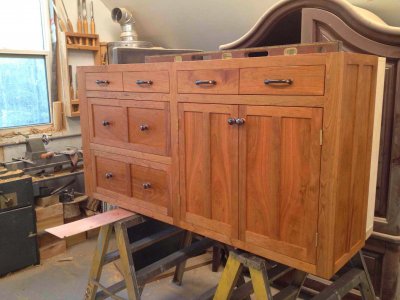What a timely question. I just received my latest copy of Fine Woodworking and they have a detailed article on wood movement in the August 2014 issue.
So, stealing a little info from that article, along with my own experience, here's some info to get you in the ballpark.
BTW, Greg, that's a beautiful cabinet.
Some basics: Wood expands and contracts mainly at right angles to it's grain. Dimensional changes along the grain are all but ignored but my general rule of thumb is 10% of the cross grain rate. I suspect you knew that already.
Cherry is listed as having a cross grain expansion rate of 3.7% for quarter-sawn and 7.1% for flat-sawn. You can generally expect there to be a 2:1 difference between flat and quarter-sawn wood for any species. This specification is for green wood to bone dry, which is about 30% to 0 moisture content. Average wood, stored indoors will run 6-12% from winter to summer in my area, New Hampshire.
Do the math: Accounting for a 6% change in moisture, using 7.1% as the maximum change over 30% that works out to be (6*7.1)/30 = 1.42% Using a 6" high drawer front, a 1.4% change would be 0.084". I would guess allowing 0.050" at top and bottom would be very adequate.
From your post it would seem you need to accommodate a greater range of moisture. I doubt the MC of your wood, even in the most humid of shops, would ever return to it's "green" level of 30%, but I've never been able to justify the cost of a good Moisture Content Meter in my wood working, so I wouldn't know.
I've also found that a good penetrating wood finish, like Tung or Danish Oil, helps slow wood's absorption of moisture. I cannot say the same for surface finishes as I rarely use them. Judging by the finish separating from the wood, and generally loosening up, on my store-bought utility items I'd say such such finishes do little at all in this regard. Not that you'll be using Polyurethane on such beautiful pieces of wood, but I've seen people whack up clear maple and walnut for kindling. If I can turn a pen or a screw plug from a piece of fine hardwood I save it.
Sorry for the long rant, I hope that helps. We'll eagerly await some progress pictures.
Best Regards,
Mark

